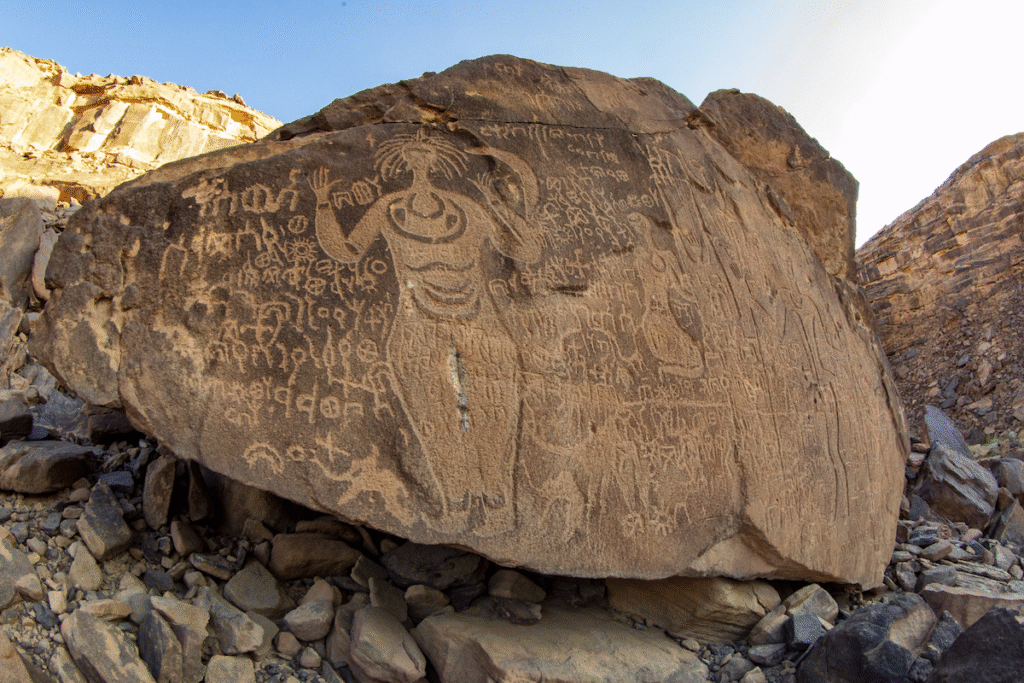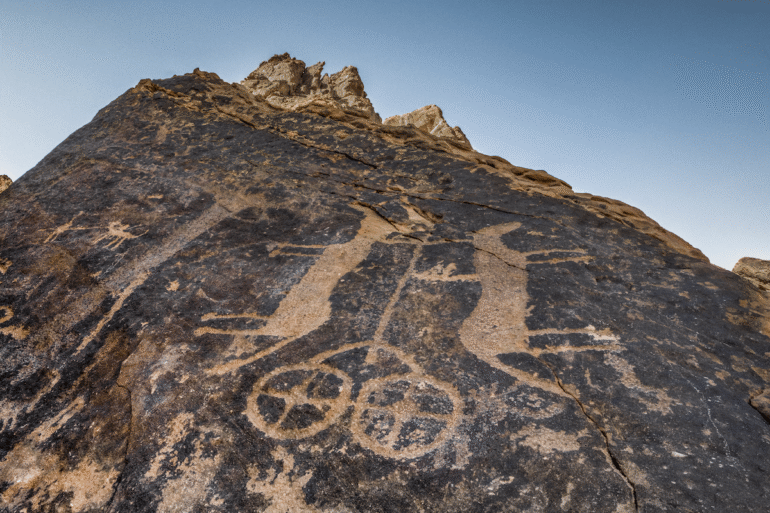Words by Jason Coe
Saudi Arabia is known for remarkable archaeological sites such as Jubbah, Bir Hima, and Tayma, where thousands of years of culture, belief, and survival are carved into stone. Carvings found at these historic sites play an important role in contemporary identity and cultural preservation, from UNESCO designations to youth education and artistic reinterpretation. In an evolving region where the past is not forgotten, but reborn, ancient petroglyphs and rock art pose the question of what cultural heritage means in contemporary times.
Etched in Stone, Etched in Spirit
The Arabian Peninsula, a land sculpted by wind and time, holds within its embrace an ancient whisper—one carved not in parchment, but in stone. Shifting golden dunes, akin to restless tides, rise beside jagged mountains that stand as timeless sentinels. Here, the desert reveals its secrets in the form of ancient petroglyphs and rock art, which silently document the complex history of past civilizations.
These are not just mere lines and markings; they represent the definitive proof of human existence, the endurance of their spirit, and a testament to the people’s resilience and respect they showed towards nature. In an environment where existence is fleeting and survival is finite, these carvings defy the harsh conditions and fading through time with their bright portrayal of life, myth, and belief. These visual echoes of ancestral voices remind us that even in the harshest of terrains, the power of imagination is prevalent and creativity flourishes.

A Journey Through Time and Terrain
The Ha’il Region – Cradle of Carvings
Nestled in the northern part of Saudi Arabia, the Ha’il region is a artistic sanctuary in the shifting sands. At Jubbah, the towering Jabal Umm Sinman looks like an open book whose pages are embellished with Neolithic masterpieces. Carved on its surface are elegant ibex, lions on the hunt, and a procession of camels. The famed “The King” panel, one of the most important carvings, stands a regal figure of authority carved in time and etched in silent grandeur.
Further south, Al-Shuwaymis unveils an even older story. Here, “Equine Hunting Scene” illustrates the very beginning of the bond between man and dog. This scene depicts a vivid struggle between man and nature as wild horses are chased by their hunters alongside their spirited canine companions. These carvings, recognized by UNESCO, are not just historical fragments, but rather an ever-present testament of the civilization’s evolution and the balance achieved between people and nature.
Southern Sands of Najran – The Battle Etched in Time
In the sun-scorched plains of Bir Hima, the rocks bear witness to layers of history. Neolithic hunters left their mark with bulls and ibex, only for Iron Age warriors to overwrite them with scenes of cavalry charges, sabers raised in defiance. The ‘A’Abar Harema Morning’ panel tells of conflict and conquest, while ‘Fardath Zamzam’ whispers of sacred rituals, a spiritual echo along ancient caravan routes.
This is where myth and history intertwine, where the stones remember not just battles, but those who fought them.

Tayma’s Whispering Stones – Al Naslaa and the North
A site quite unlike any other, Al Naslaa is home to an incredible sandstone monolith that seems to be cut with geometric precision by divine hands. On either side, the forms of an Arabian horse and a rider are eternally galloping across the weathered stone. Nearby, Al Naslaa 2 and Al Daksh Detail reveal confrontations between mounted warriors, their stylized figures a blend of artistry and ancient mysticism.
Here, nature and human expression blur—where the earth itself seems to conspire with the ancients to create something transcendent.
The Meaning Behind the Marks and the Change to Come
These carvings are more than historical records; they are beliefs in stone, etchings of the sacred, and echoes of voices lost in the desert. Across the vast expanse of Arabia, common themes emerge—fertility, death, hunting, divinity—revealing a shared cultural tapestry woven across time.
The petroglyphs are an art form that is known to all, defying language barriers and eras, merging the bygone with contemporary life in a wordless communication. They are the collective memory of a people, a spiritual compass pointing toward the eternal.
Yet, these old voices face new challenges—fierce winds, urbanization, and the harsh hands of mass tourism. Understanding their sensitivity, Saudi Arabia has set out on a mission of safeguarding, alongside UNESCO and global professionals to catalog, restore, and protect these ancient wonders.
This is more than archaeology—it is a moral duty, a vow to safeguard the whispers of our ancestors so that future generations may hear them too.
The spirit of Arabia’s rock art lives on, not just in stone, but in the hearts of modern artists who draw inspiration from these ancient motifs. Through contemporary exhibitions, augmented reality experiences, and youth education programs, the past is being reimagined, ensuring its survival in a digital age. This is the endurance of tradition—not as a relic, but as a living force, evolving yet eternal.
The stones of Arabia still speak, if we are willing to listen. They tell of hunters and kings, of wars and worship, of humanity’s unbroken bond with the land. They are more than art—they are memory carved in eternity. In the desert, the past is never truly lost—it is only waiting to be rediscovered.
This article by Jason Coe (Canvas Central) part of an ongoing initiative between Canvas Central, the digital offshoot of Canvas Magazine, and the Saudi Arabian Ministry of Culture to spotlight culturally significant stories.



